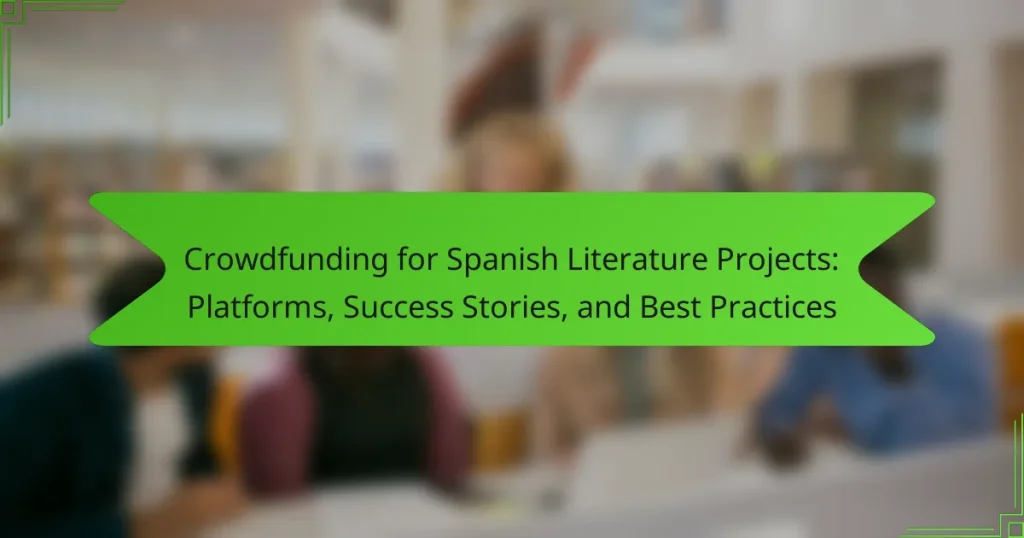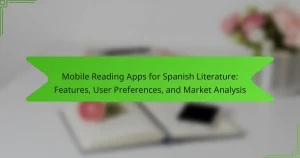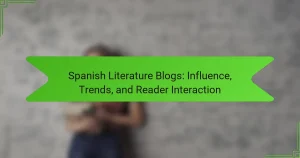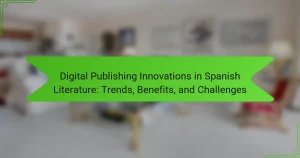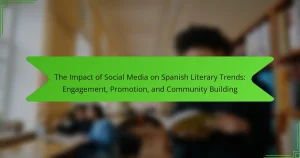Crowdfunding can significantly boost Spanish literature projects by providing essential financial support. Key platforms like Kickstarter, Indiegogo, and Verkami offer unique features tailored for creative initiatives. Successful case studies demonstrate effective strategies and community engagement. However, challenges such as limited visibility and audience engagement must be addressed for optimal success.
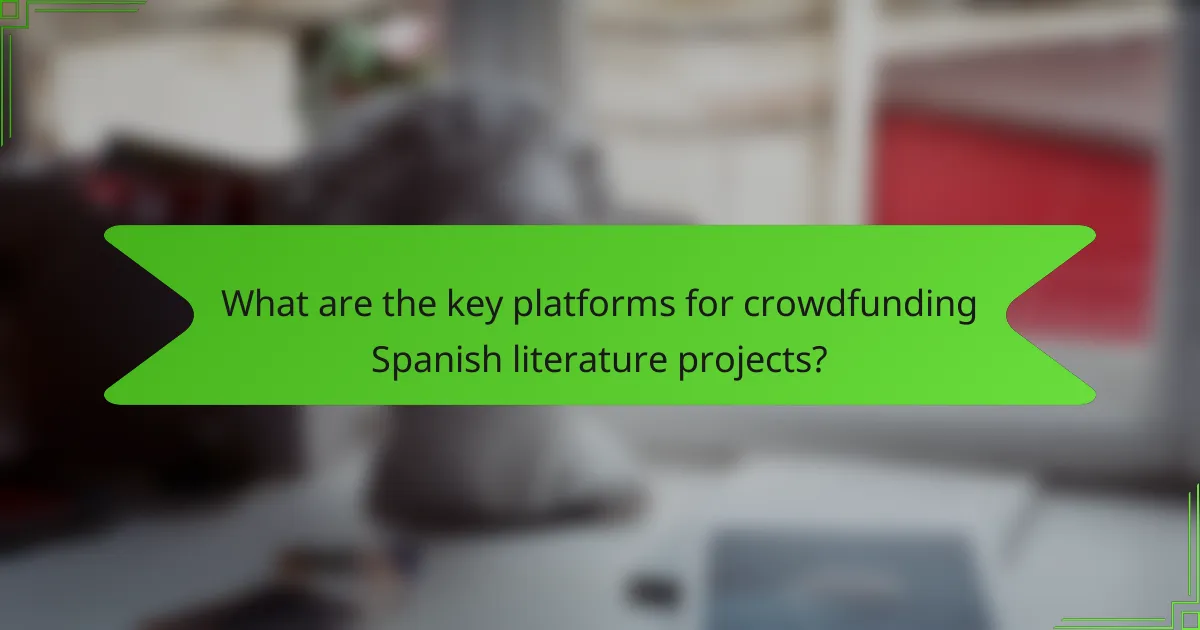
What are the key platforms for crowdfunding Spanish literature projects?
Key platforms for crowdfunding Spanish literature projects include Kickstarter, Indiegogo, Verkami, and Goteo. These platforms cater specifically to creative projects, providing unique features that support authors and literary initiatives. For example, Verkami focuses on Spanish-speaking creators, enhancing community engagement. Goteo emphasizes social impact, allowing projects with a cultural focus to thrive. Each platform offers distinct funding models and audience reach, making them vital for literature projects seeking financial backing.
How do platforms differ in their approach to literary projects?
Platforms differ in their approach to literary projects by varying their funding models, audience engagement strategies, and project support mechanisms. Some platforms focus on rewards-based crowdfunding, offering backers tangible items, while others prioritize patronage models, fostering long-term relationships between creators and supporters.
For example, platforms like Verkami emphasize community involvement and storytelling, encouraging creators to share their journey. In contrast, Kickstarter provides a more transactional experience, where backers primarily seek unique products. Each platform’s unique attributes shape the success of Spanish literature projects, influencing how creators connect with their audience and secure funding.
Which platforms have the highest success rates for literature funding?
Kickstarter and Indiegogo are among the platforms with the highest success rates for literature funding. Both have successfully funded numerous Spanish literature projects, showcasing their effectiveness. Kickstarter reports a success rate of around 38%, while Indiegogo offers flexible funding options that cater to diverse project needs. Other notable platforms include Verkami, which focuses on Spanish-speaking creators and has a strong community support system. Additionally, Goteo supports social and cultural projects, enhancing the chances of funding success.
What are the fees and costs associated with each platform?
The fees and costs associated with crowdfunding platforms for Spanish literature projects vary significantly. Most platforms charge a percentage of the funds raised, typically ranging from 5% to 10%. Additionally, some platforms may impose payment processing fees, which can be around 3% to 5%.
| Platform | Percentage Fee | Payment Processing Fee | Total Estimated Cost |
|——————-|—————-|———————–|———————-|
| Kickstarter | 5% | 3% | 8% |
| Indiegogo | 5% | 3% | 8% |
| Verkami | 5% | 3% | 8% |
| Goteo | 5% | 2.5% | 7.5% |
| Ulule | 8% | 3% | 11% |
Consider these fees when planning your budget to ensure project viability.
How can creators choose the right platform for their specific needs?
Creators should evaluate their project goals, audience engagement, and funding needs to choose the right crowdfunding platform. Key factors include platform fees, audience reach, and project visibility. Popular platforms like Kickstarter and Indiegogo cater to diverse creative projects, while specialized platforms like Verkami focus on Spanish literature. Success stories often highlight the importance of effective marketing and community building. Ultimately, aligning platform features with project attributes enhances the chances of funding success.

What are the common challenges faced in crowdfunding Spanish literature projects?
Crowdfunding for Spanish literature projects often faces challenges such as limited visibility, audience engagement, and funding competition. Many creators struggle to effectively promote their projects, making it difficult to reach potential backers. Additionally, the niche nature of Spanish literature can restrict the audience size, impacting overall funding success. Establishing trust and credibility is another hurdle, as new authors may lack an established reputation.
How do cultural perceptions impact fundraising efforts?
Cultural perceptions significantly influence fundraising efforts for Spanish literature projects. Understanding local values and traditions can enhance engagement and support. For instance, projects that resonate with cultural pride often see higher success rates. Additionally, incorporating local languages and themes can attract more backers, as they feel a personal connection to the project.
What are the typical funding goals for literary projects?
Typical funding goals for literary projects often range from $5,000 to $50,000. These goals vary based on project scope, target audience, and production costs. Successful crowdfunding campaigns for Spanish literature projects frequently aim for specific milestones like book publication, marketing efforts, or author tours. Engaging storytelling and clear project objectives can significantly enhance funding success.
Which marketing strategies are most effective in overcoming these challenges?
Crowdfunding for Spanish literature projects thrives through targeted marketing strategies. Engaging storytelling, leveraging social media, and building community partnerships significantly enhance project visibility and funding success.
Effective marketing strategies include creating compelling narratives that resonate with potential backers, utilizing platforms like Instagram and Twitter to share updates, and collaborating with literary influencers to reach wider audiences. These approaches not only attract funding but also foster a loyal supporter base.
Success stories illustrate the power of these strategies. For instance, projects that effectively communicate their unique attributes, such as cultural significance or innovative formats, often achieve higher funding levels.
Additionally, utilizing email marketing to maintain engagement and provide updates can reinforce community support. These strategies collectively address challenges in visibility and funding, making crowdfunding a viable option for Spanish literature projects.
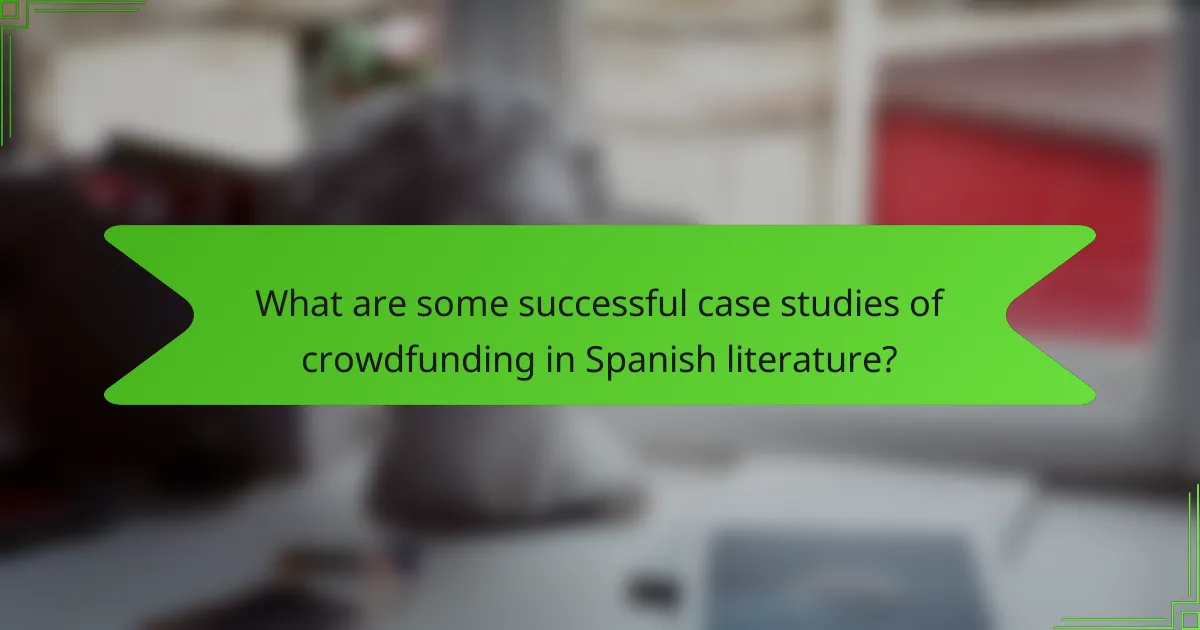
What are some successful case studies of crowdfunding in Spanish literature?
Successful case studies of crowdfunding in Spanish literature include notable projects that have achieved significant funding and community engagement. One example is “La Casa de los Espíritus” by Isabel Allende, which successfully raised funds to adapt the novel into a graphic format. Another case is the crowdfunding campaign for “El Laberinto de los Espíritus” by Carlos Ruiz Zafón, which attracted a large audience and exceeded its funding goals, showcasing the potential of crowdfunding to support literary adaptations. Additionally, the platform Verkami has facilitated numerous successful campaigns, highlighting best practices such as engaging storytelling and community involvement. These examples illustrate how crowdfunding can empower Spanish literature projects and connect authors with their audiences.
What strategies did successful projects employ to engage backers?
Successful projects engaged backers by employing targeted marketing strategies, building community connections, and offering attractive rewards. They utilized social media platforms to create buzz and reach wider audiences. Engaging storytelling highlighted the project’s purpose, fostering emotional connections with potential backers. Regular updates maintained interest and encouraged ongoing support.
How did funding levels vary across different types of literary projects?
Funding levels for literary projects vary significantly based on project type. Crowdfunding for Spanish literature projects shows diverse funding outcomes influenced by project scope and engagement strategies.
For instance, poetry collections often attract smaller amounts, averaging around $2,000, while novel projects can exceed $10,000 due to broader audience appeal. Non-fiction projects, particularly those focusing on cultural topics, can achieve funding levels between $5,000 and $15,000, depending on the platform used and marketing efforts.
Success stories highlight that projects with strong community ties and effective social media campaigns tend to secure higher funding. Platforms like Verkami and Goteo have proven beneficial for Spanish literary initiatives, showcasing how targeted approaches impact funding success.
What lessons can be learned from failed crowdfunding attempts?
Failed crowdfunding attempts offer valuable lessons for future projects. Key takeaways include the importance of clear communication, setting realistic funding goals, and engaging potential backers early. A well-defined project narrative enhances appeal. Additionally, understanding the target audience’s preferences can significantly boost success rates. Learning from these factors can guide creators in crafting more effective campaigns.
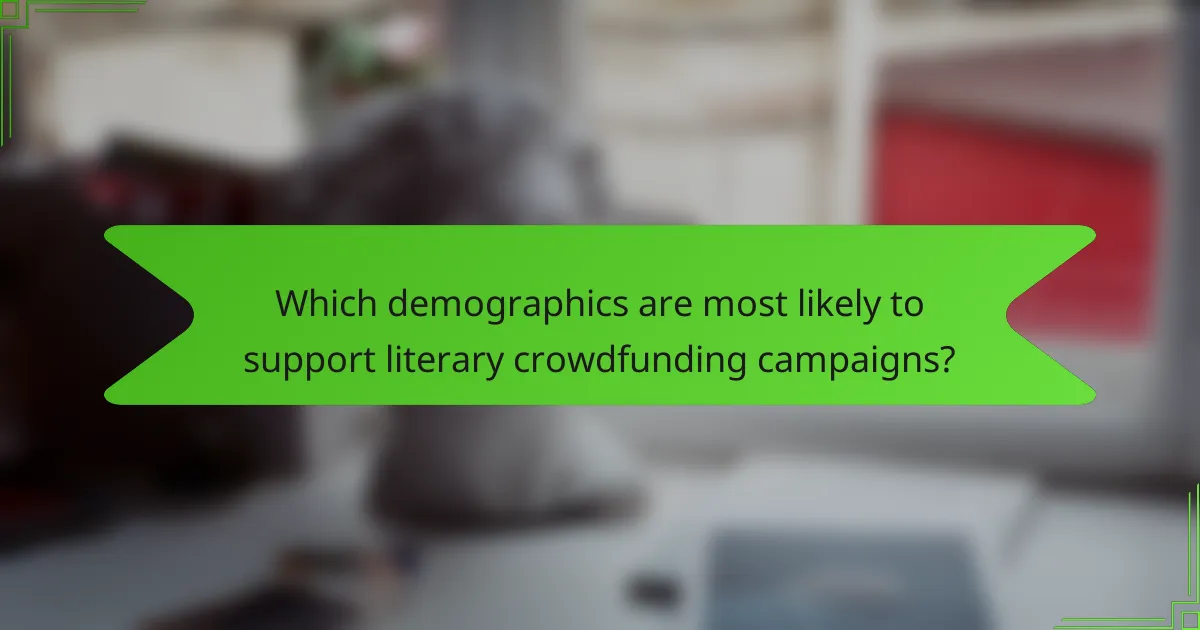
Which demographics are most likely to support literary crowdfunding campaigns?
Younger adults aged 18-34 are most likely to support literary crowdfunding campaigns. This demographic is typically more engaged with digital platforms and values unique literary projects. Additionally, individuals with higher education levels tend to contribute more, as they often appreciate the cultural significance of literature. Social media influence also plays a crucial role, as campaigns promoted through these channels attract more supporters from diverse backgrounds.
How do age and location influence backer behavior?
Age and location significantly influence backer behavior in crowdfunding for Spanish literature projects. Younger backers often prefer digital platforms, while older individuals may favor traditional methods. Geographic location affects cultural interests and project relevance, impacting funding levels. For instance, backers in urban areas may support diverse projects, while those in rural regions might focus on local narratives. Understanding these dynamics helps creators tailor their campaigns effectively.
What role do social media and community engagement play in attracting supporters?
Social media and community engagement significantly enhance the ability to attract supporters for crowdfunding Spanish literature projects. Active online presence fosters connections, builds trust, and encourages participation. Engaging content, such as updates and success stories, can motivate potential backers to contribute. Community-driven campaigns often see higher success rates due to shared enthusiasm and collective support. Additionally, leveraging platforms like Twitter or Facebook can amplify reach, engaging a wider audience interested in literature.

What best practices should creators follow for successful crowdfunding campaigns?
Successful crowdfunding campaigns for Spanish literature projects require clear goals, engaging storytelling, and effective outreach. Creators should define their target audience and tailor their messaging accordingly. Building a community around the project enhances credibility and support. Utilizing social media and email marketing can significantly increase visibility. Regular updates during the campaign keep backers informed and engaged. Lastly, offering unique rewards related to the literary project can incentivize contributions.
How can creators effectively communicate their project vision?
Creators can effectively communicate their project vision by clearly articulating goals, engaging storytelling, and utilizing visual elements. They should define their unique attributes, such as cultural significance and community impact, to resonate with potential backers. Providing relatable success stories from previous Spanish literature projects can enhance credibility and inspire trust. Additionally, leveraging social media platforms can amplify their message and reach wider audiences, fostering a supportive community around their project.
What are the most effective reward structures for backers?
Effective reward structures for backers in crowdfunding Spanish literature projects include tiered incentives, exclusive content, and personalized rewards. Tiered incentives encourage higher contributions by offering increasing benefits, such as signed copies or early access. Exclusive content, like behind-the-scenes updates or author interviews, creates a sense of belonging. Personalized rewards, such as custom thank-you notes or acknowledgments in the book, enhance engagement. These strategies foster a community around the project while motivating backers to support the initiative.
How important is project presentation and storytelling in attracting funding?
Project presentation and storytelling are crucial for attracting funding in crowdfunding for Spanish literature projects. A compelling narrative engages potential backers emotionally, making them more likely to invest. Successful campaigns often feature strong visual elements and clear messaging about the project’s impact. For instance, storytelling can highlight unique aspects of the literature, such as cultural significance or innovative themes. As a result, projects with well-crafted presentations tend to achieve higher funding levels and broader support.
What common mistakes should creators avoid in their campaigns?
Creators should avoid unclear goals, insufficient research, and lack of audience engagement in their crowdfunding campaigns. These mistakes can hinder funding success and project visibility. Clear objectives help align messaging, while understanding the audience ensures relevant content. Engaging potential backers fosters community support, essential for reaching funding targets.
